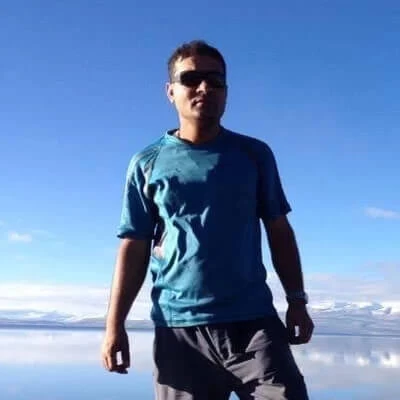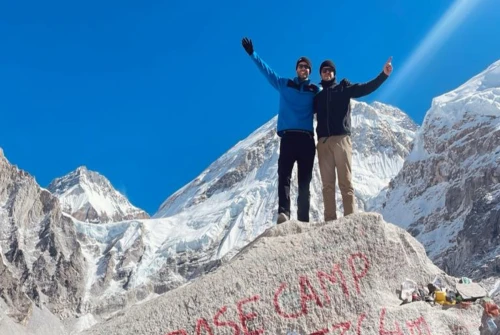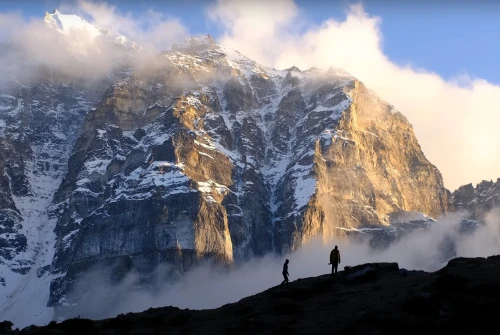Can Acute Mountain Sickness happen in Nepal?
Fact: 14 mountains in Nepal are above 8,000 meters and 8 of them lie in Nepal.
This may give you the slightest idea of how many places are there in Nepal where anyone can be affected by high altitude sickness in Nepal.
So, this can happen while you are visiting Nepal.
What is Acute Mountain Sickness (AMS)?
In simple, Acute Mountain Sickness (AMS) is a condition that can occur when anyone travels to higher altitudes too quickly without giving the body adjust to the environment.
Above 2500m, the concentration of oxygen in the air you breathe starts to drop off markedly, reducing the amount of oxygen that reaches your brain and other organs. Decreasing air pressure at altitude has the additional effect of causing the liquid to leak from capillaries into the lungs and brain, which can be fatal.
The human body can adjust to the changes in pressure and oxygen concentration as you gain altitude, but this is a gradual process.
The health conditions caused by the effects of altitude are known collectively as altitude sickness or acute mountain sickness (AMS).
If allowed to develop unchecked, AMS can lead to coma and death. However, you can avoid the potentially deadly condition by limiting your rate of ascent, which will allow your body to adjust to the altitude. There is also a 100% effective treatment if you do experience serious symptoms: descend immediately.
If you go trekking, it is important to read up on the causes, effects, and treatment of altitude sickness before you start walking. Attend one of the free lectures on altitude sickness given by the Himalayan Rescue Association in Kathmandu, Nepal.
The onset of symptoms of AMS is usually gradual, so there is time to adjust your trekking schedule or retreat off the mountain if you start to feel unwell. Most people who suffer severe effects of AMS have ignored obvious warning signs.
Acclimatization
The process of acclimatization is still not fully understood, but it is known to involve modifications in breathing patterns and heart rate and an increase in the oxygen-carrying capacity of the blood.
Some people have a faster rate of acclimatization than others, but almost anyone can trek to high altitudes as long as the rate of ascent does not exceed the rate at which their body can adjust.
AMS is a notoriously fickle affliction and it can affect trekkers and walkers who are accustomed to walking at high altitudes as well as people who have never been to altitude before.
AMS has been fatal at 3000m, although 3500m to 4500m is the usual range.
Symptoms of AMS
On treks above 4000m, a lot of trekkers experience mild symptoms of altitude sickness- breathlessness and fatigue to reduced oxygen in the blood are the most common.
Mild symptoms usually pass if you stop ascending and give your body time to ‘catch up with the increase in altitude where you first developed symptoms, you should be able to slowly continue your ascent. Serious symptoms are a different matter- if you develop any of the symptoms described here, you should descend immediately.
1. Mild Symptoms
Mild symptoms of AMS are experienced by many travelers above 2800m. Some of the mild symptoms that can happen to hikers are
- Headache,
- Nausea and Vomiting
- Dizziness
- Loss of appetite
- Difficulty in Sleeping
- Muscle ache
Never ignore mild symptoms of AMS- this is your body giving you an alarm call. You may develop more serious symptoms if you continue to ascend without giving your body time to adjust.
2. Serious Symptoms
Serious symptoms are caused by the accumulation of fluid in the lungs and brain and include breathlessness at rest, a dry, irritative cough, severe headache, lack of coordination, confusion, irrational behavior, vomiting, and eventually unconsciousness and death.
If you ignore the mild symptoms then you can experience serious symptoms which can be dangerous. Some of them are
- Chest Congestion
- Shortness of breath
- Coughing
- Difficulty in walking
- Lack of balance
There are 2 cases of serious symptoms that can happen to you.
- High Altitude Pulmonary Edema (HAPE):- When a not healthy person reached an altitude of more than 8200 feet (2500 meters), then he/she can suffer from HAPE. It can lead to the death of a person. Some of the symptoms are dry cough, dyspnea, and fatigue.
- High Altitude Cerebral Edema (HACE):- When a person travels to a high altitude, he may have swelling of the brain, this is HACE. It can occur before HAPE and AMS and normally occurs below 3,000 meters. Some of the symptoms are Fever, headache, and an increase in heart rate.
Should you be afraid of Acute Mountain Sickness?
Neither everyone must be afraid of AMS, nor you should ignore this menacing disease. You must be careful if you have the following cases
- Have lung or heart disease.
- Live at sea level and never travel to high altitudes.
- Low Red Blood Cell count.
- You travel to high altitudes faster.
- Last, but not least, If you have experienced it before.
Prevention of Acute Mountain Sickness
You may be aware of the phrase, “Prevention is better than cure”. Well, this applies here too.
If you trek above 2500m, observe the following rule
- Ascend slowly:- Where possible, do not sleep more than 300m higher than the elevation where you spent the previous night. If any stage on a trek exceeds this increase in elevation, take at least one rest day to acclimatize before you start the ascent. If you or anyone else in your party seems to be struggling, take a rest day as a precaution.
- Climb high, sleep low:- It is always wise to sleep at a lower altitude than the greatest altitude reached during the day. If you need to cross a high pass, take an extra acclimatization day before you cross. Be aware that descending to the altitude where you slept the previous night might not be enough to compensate for a very large increase in altitude during the day.
- Trek Healthy:- You are more likely to develop AMS if you are already tired, dehydrated, or malnourished. Drink extra fluids while trekking. Avoid sedatives or sleeping pills and don’t smoke – this will further reduce the amount of oxygen reaching your lungs.
- If you feel unwell, stop:- If you start to display mild symptoms of AMS, stop climbing. Take an acclimatization day and see if things improve. If your symptoms stay the same or get worse, descend immediately. If on an organized trip, make sure your tour leader is aware of your condition. Don’t feel pressured to continue ascending just to keep up with your group.
- No use of alcohol, tobacco, or any medications:- Do not consume these products even before 48 hours you start trekking as it can have a negative reaction in your body.
Treatment of Acute Mountain Sickness
Till now, we have talked about everything about what we can do to prevent it from happening. But if you are already on the journey, and something happens to you. Then what treatment can you do?
For Mild Symptoms
- Take rest at the same altitude and if necessary, step down until recovery.
- Take paracetamol or aspirin for headaches:- Diamox (acetazolamide) can be used to reduce mild symptoms of AMS. However, it is not a cure and it will not stop you from developing serious symptoms. The usual dosage of Diamox is 125mg to 250mg twice daily.
- Hydrate yourself:- The medication is a diuretic so you should drink extra liquid to avoid dehydration. Diamox may also cause disturbances to vision and the sense of taste and it can cause a harmless tingling sensation in the fingers.
- Keep yourself warm.
For Severe symptoms
- Descend asap:- The best and foremost thing anyone can do if AMS happens is to descend quickly from the altitude. Ideally, this should be below the altitude where you slept the night before you first developed symptoms. Most lodges can arrange an emergency porter to help you descend quickly to a safe altitude.
- Emergency treatments for serious symptoms of AMS include supplementary oxygen, nifedipine, dexamethasone, and depressurization using a device known as a Gamow bag (this should only be performed by a health professional), but these only reduce the symptoms and they are not ‘cure’.
- Get health advice:- The first and last thing you can do is to get medical attention as soon as possible.
So, these are the things you must consider if you are planning to trek in the higher region of Nepal. Always be prepared before you start your journey as AMS can happen to anyone at any time.


.webp)

